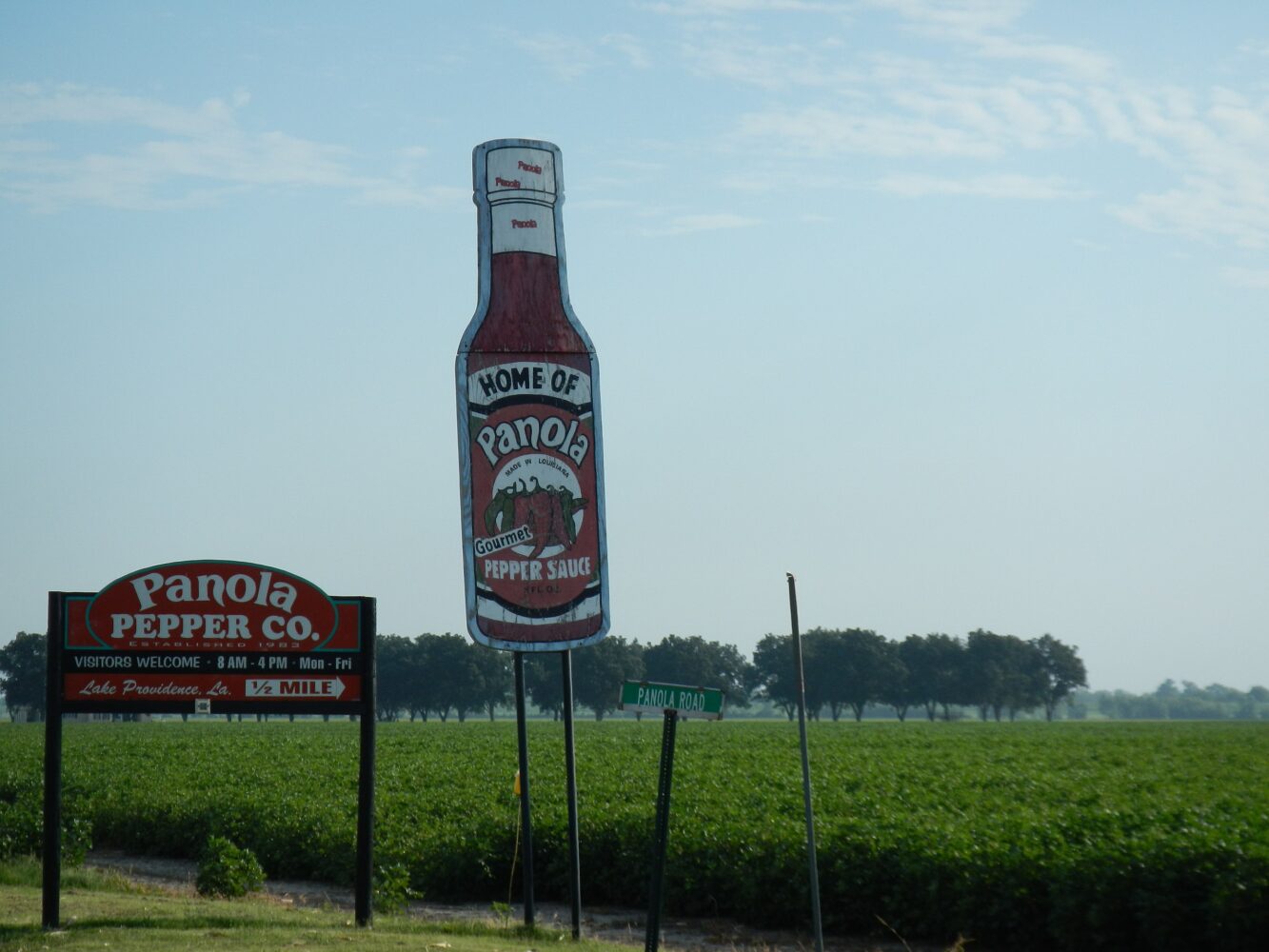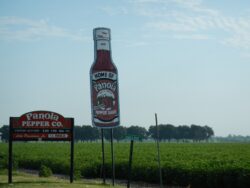Summer 2011
Hot Splashes
Fermented chile sauces are a common fixture on Louisiana tables
Published: July 27, 2021
Last Updated: August 23, 2021

Wikimedia Commons user MD Childress
Tables in Uptown New Orleans are often graced with filigreed silver holders designed to hold bottles of the South’s incendiary elixir— Tabasco. In my part of town, tables may be topped with a more modest presentation, but dining rooms are pretty much guaranteed to hold a bottle of Crystal or Louisiana Red or perhaps both? There might even be a bottle of yellow peppers marinating in vinegar known as sport peppers. Hot sauces, homemade and store-bought, have long been an integral part of Louisiana tablescapes. South Louisiana is in fact one of the northernmost points in an international band of cuisines where hot sauces are an inescapable condiment.
The name of the first person to grow Tabasco chiles—so called for the province in Mexico where they reportedly were first cultivated—in the United States is disputed. Some say it was Col. Maunsel White, a prominent banker and Louisiana legislator. Others suggest it was Edmund McIlhenny, inventor of Tabasco brand pepper sauce. A third variant votes for McIlhenny, but embroiders on the chile’s origin with the tale of a soldier returning from the Mexican War who gave Edmund a gift of dried Mexican peppers. Whatever the source for the chiles, there’s no disputing that many of the first manufactured pepper sauces in the country came from southern Louisiana. Indeed, McIlhenny and White began selling their products within four years of each other and McIlhenny’s Tabasco is certainly one of the world’s most recognized brands.
No matter what the source of his peppers, McIlhenny certainly recognized a good thing. He planted the seeds of the Tabasco peppers on his Avery Island plantation, located about seven miles south of New Iberia, La. Unfortunately for hot sauce lovers, the Civil War interrupted things for a number of years, particularly when the Union troops captured New Orleans and the McIlhenny family fled to San Antonio in 1863. Upon their return to Avery Island after the war, the McIlhenny family found its sugar cane crop decimated. But the chiles remained. Edmund McIlhenny used them to make the sauce that he first bottled in old cologne bottles. McIlhenny applied for and received a patent for his Tabasco sauce in 1870.
The popularity of McIlhenny’s sauce launched a host of variants and numerous other Louisiana-style hot sauces were developed in the late 19th and early 20th centuries. A former McIlhenny employee named B.F. Trappey began growing tabasco chiles from Avery Island seed and came up with his eponymous sauce in 1896. With a rating of 1,200 to 1,600 on the Scoville chile heat-rating scale, Trappey’s Louisiana hot sauce is noticeably milder than most of its peers.
Other competitors included: Red Hot Creole Peppersauce (1916), Crystal Hot Sauce (1923), and Original Louisiana Hot Sauce (1928). In total there are more than 35 manufacturers in Louisiana, which produce about a hundred different variants of hot sauce.
Louisiana hot sauces are usually composed of some combination of chile pepper, vinegar and salt. Peppers used are often of the varieties cayenne, jalapeño and habanero, but nowadays chipotles are also common. Some hot sauces follow the Tabasco model and are aged in wooden casks, similar to the preparation of wine, and fermented and balsamic vinegars.
Other ingredients, including fruits and vegetables such as raspberries, mangoes, carrots, and chayote squash are sometimes used to add flavor, mellow the heat of the chiles, and thicken the sauce’s consistency. While Tabasco has conquered the world and turns up in restaurants and on bars from Ponchatoula to Paris and Lafayette to London, favorites like Crystal, Frank’s Red Hot and Original Louisiana Hot Sauce are still very much present on local tables.
Whether in South Louisiana or not, African Americans have had a long-recorded love of hot sauces. In fact, slave traders even commented on a generalized African, ”taste for the bite-y.” Reportedly archaeologists digging at the site of a black-owned saloon in the Old West mining town of Virginia City, Nev. (near Reno) recently uncovered a 130-year-oldnbottle of Tabasco. Another condiment found mostly in African-American neighborhoods has begun to intrigue me—sport peppers. These small yellow chiles that are pickled in vinegar and served in a shaker bottle that dispenses the hot vinegar. They are just zingy enough to brighten up a plate of collard greens or add some zip to a rich, brown gravy. Sport peppers interest me for two reasons. First, they are similar in presentation and taste to a table condiment used in northeastern Brazil called pimenta malagueta. Indeed, the Mississippi sport pepper, as the cultivar is known, is a plant of the genus Capsicum annum and is thought to have originated in Bolivia or southern Brazil. The chiles used in pimenta malagueta are hotter, but the idea of using the chile-flavored vinegar to spice up food is the same. Both sport peppers and pimenta malagueta are classic table condiments of the African diaspora. Sport peppers indeed have their own scattering and show up in unusual places. They are an indispensable ingredient in the making of a Chicago hot dog, where they are minced and layered with other toppings, making for a savory dog indeed.
I was then intrigued by the etymology of the term “sport peppers,” which brought to mind the bowler hats and spats and big city mannerisms of the character Sportin’ Life in the Gershwin opera Porgy and Bess. A glance at a dictionary of African-American slang revealed that the “sportin’ life” was a “Black subculture that developed in some North American cities, wherein blacks, frustrated by limited opportunities and discrimination, turned to illegal activities like gambling, prostitution, and drug dealing to earn a living and gain status.
Blacks living the “sporting life” congregated at certain clubs and hangout spots in the cities. Considering the south to north axis of the sport peppers’ use, they are probably a gustatory witness to Great Migration of African Americans in the 20th century. They and the South Louisiana hot sauces that are their culinary kin continue to serve as potent reminders of the enduring ability of food to trace the lines of history.
Jessica B. Harris is the author, editor, or translator of eighteen books, including twelve cookbooks documenting the foodways of the African Diaspora. In March of 2020, she became a James Beard Lifetime Achievement awardee.
